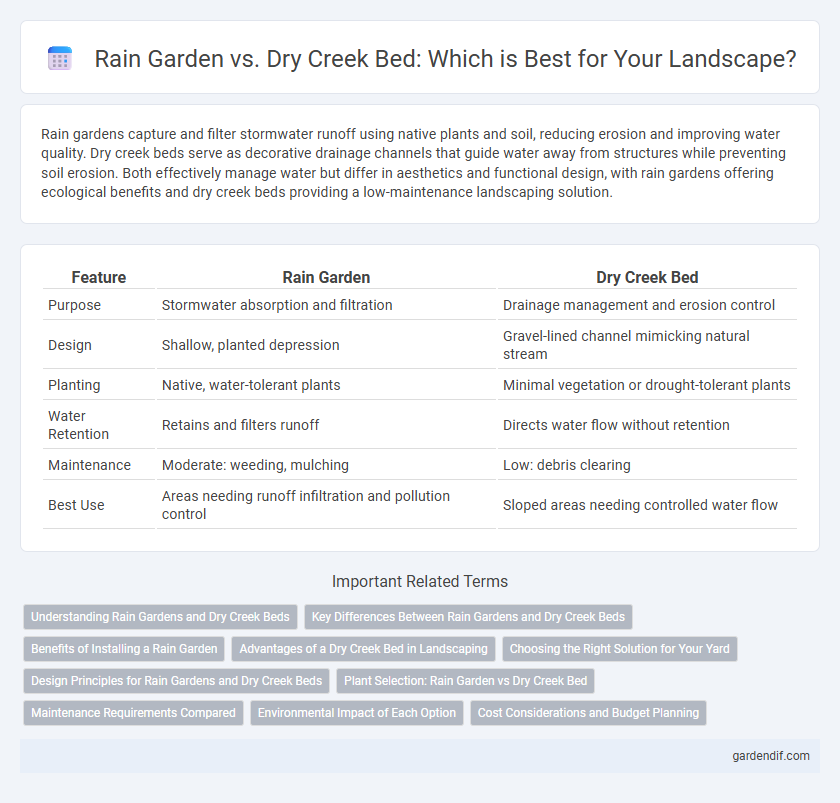
Rain Garden vs Dry Creek Bed Illustration
Rain gardens capture and filter stormwater runoff using native plants and soil, reducing erosion and improving water quality. Dry creek beds serve as decorative drainage channels that guide water away from structures while preventing soil erosion. Both effectively manage water but differ in aesthetics and functional design, with rain gardens offering ecological benefits and dry creek beds providing a low-maintenance landscaping solution.
Table of Comparison
| Feature | Rain Garden | Dry Creek Bed |
|---|---|---|
| Purpose | Stormwater absorption and filtration | Drainage management and erosion control |
| Design | Shallow, planted depression | Gravel-lined channel mimicking natural stream |
| Planting | Native, water-tolerant plants | Minimal vegetation or drought-tolerant plants |
| Water Retention | Retains and filters runoff | Directs water flow without retention |
| Maintenance | Moderate: weeding, mulching | Low: debris clearing |
| Best Use | Areas needing runoff infiltration and pollution control | Sloped areas needing controlled water flow |
Understanding Rain Gardens and Dry Creek Beds
Rain gardens are shallow, vegetated basins designed to capture and absorb stormwater runoff, promoting groundwater recharge and reducing erosion. Dry creek beds serve as decorative drainage features that channel excess water through a natural-looking stone-lined pathway, preventing water pooling and soil erosion. Both systems manage runoff effectively but differ in water infiltration and aesthetic function within landscape design.
Key Differences Between Rain Gardens and Dry Creek Beds
Rain gardens are shallow, planted depressions designed to absorb and filter rainwater runoff, promoting groundwater recharge and reducing erosion, while dry creek beds are engineered channels with rocks or gravel that direct excess water flow away from structures without significant infiltration. Rain gardens emphasize water retention and pollutant removal through soil and vegetation, whereas dry creek beds focus primarily on drainage and preventing stormwater damage. Both effectively manage stormwater but differ in ecological function and design purpose within landscape planning.
Benefits of Installing a Rain Garden
Installing a rain garden significantly improves stormwater management by capturing and filtering runoff, reducing erosion and water pollution. These gardens support native plants, enhancing local biodiversity and creating habitat for pollinators like bees and butterflies. Rain gardens also help recharge groundwater, contributing to sustainable landscape practices and reducing the burden on municipal drainage systems.
Advantages of a Dry Creek Bed in Landscaping
A dry creek bed offers superior erosion control by efficiently directing stormwater runoff away from vulnerable areas, reducing soil displacement and water damage. It enhances landscape aesthetics with a natural, textured appearance that blends seamlessly with various garden styles while providing a low-maintenance alternative to traditional drainage systems. The dry creek bed also promotes groundwater recharge by allowing water to percolate through permeable materials, supporting sustainable landscape practices.
Choosing the Right Solution for Your Yard
Rain gardens absorb and filter stormwater using native plants, ideal for areas with moderate rainfall and poor drainage, promoting biodiversity and reducing runoff. Dry creek beds offer a decorative drainage solution for yards with heavy water flow or erosion issues, channeling excess water safely away from structures. Selecting between the two depends on your yard's soil type, water volume, and desired aesthetic, ensuring effective water management and landscape enhancement.
Design Principles for Rain Gardens and Dry Creek Beds
Rain garden design principles emphasize selecting native, water-tolerant plants with deep root systems to enhance infiltration, combined with an inward sloping basin to capture runoff efficiently. Dry creek bed design prioritizes using permeable materials like gravel and river rock to direct stormwater flow while preventing erosion and promoting groundwater recharge. Both designs require grading for proper drainage and integrating soil amendments to improve water retention and filtration.
Plant Selection: Rain Garden vs Dry Creek Bed
Rain gardens feature moisture-loving plants like sedges, ferns, and native wildflowers that thrive in periodically wet conditions, promoting water infiltration and supporting local biodiversity. Dry creek beds favor drought-tolerant, xerophytic plants such as ornamental grasses, succulents, and hardy shrubs that withstand well-drained, dry soils while enhancing landscape aesthetics. Selecting appropriate plants based on soil moisture variability ensures effective stormwater management and sustainable landscape design for both rain gardens and dry creek beds.
Maintenance Requirements Compared
Rain gardens typically require regular maintenance such as weeding, mulching, and monitoring water flow to ensure plant health and effective stormwater infiltration. Dry creek beds demand less frequent upkeep, mainly involving debris removal and occasional realignment of stones to maintain proper drainage. Selecting between these options depends on desired maintenance intensity and landscape functionality.
Environmental Impact of Each Option
Rain gardens effectively reduce stormwater runoff by absorbing and filtering pollutants through native plants and soil, enhancing groundwater recharge and supporting biodiversity. Dry creek beds primarily serve as drainage features, preventing erosion and directing water flow without significant pollutant filtration or groundwater infiltration. Choosing rain gardens contributes more substantially to water quality improvement and ecological benefits in sustainable landscape management.
Cost Considerations and Budget Planning
Rain gardens typically involve moderate installation costs due to soil amendments, native plants, and permeable materials, whereas dry creek beds may incur higher expenses from rock sourcing, excavation, and structural design. Budget planning for rain gardens often emphasizes long-term savings through stormwater management and irrigation reduction, while dry creek beds require upfront investment but offer durable erosion control with minimal maintenance. Comparing cost considerations, landscape professionals recommend assessing site-specific drainage needs and material availability to optimize financial and environmental benefits.
Rain Garden vs Dry Creek Bed Infographic

 gardendif.com
gardendif.com